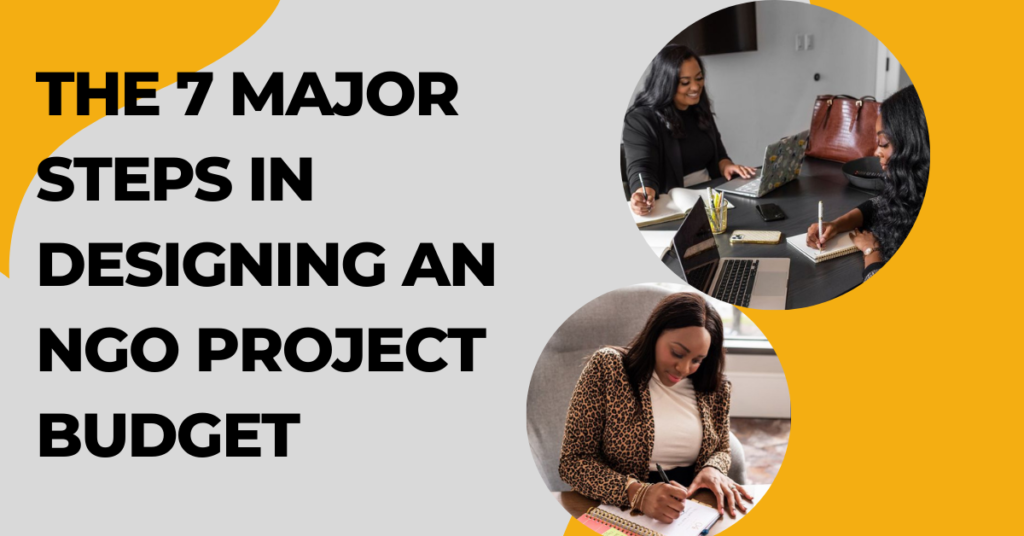
Menu
Facebook-f
Twitter
Google-plus-g
The 7 Major Steps in Designing an NGO Project Budget
Designing a budget is a vital part of planning any NGO project. It helps you understand how much money you need, how you’ll spend it, and where it will come from. A well-structured budget ensures that your project runs smoothly and that you can meet your goals without running into financial trouble. Whether you’re managing a small community initiative or a large-scale program, understanding how to create an effective budget is crucial. This guide will walk you through the steps of designing an NGO project budget using simple, straightforward language.
Step 1: Understand the Types of Costs
Before you start creating your budget, it’s important to understand the different types of costs involved in your project. Costs are generally divided into two main categories: direct costs and indirect costs.
- Direct Costs: These are expenses that are directly related to the project and can be easily attributed to specific activities. Examples include:
- Personnel Costs: Salaries or wages for staff working directly on the project. This might include project managers, field workers, and administrative staff.
- Supplies and Materials: Items you need to carry out the project, such as educational materials, medical supplies, or construction materials.
- Travel Costs: Expenses related to traveling for the project, including transportation, accommodation, and meals.
- Equipment Costs: Purchases or rentals of equipment necessary for the project, such as computers, projectors, or vehicles.
- Contract Services: Payments to consultants or contractors who provide specific services or expertise.
- Indirect Costs: These are general expenses that support the project but aren’t directly tied to specific activities. Examples include:
- Administrative Costs: Overhead expenses like office rent, utilities, and salaries for administrative staff.
- General Office Supplies: Items such as paper, pens, and office furniture.
Step 2: Estimate Your Costs
Once you know what types of costs you’ll have, you need to estimate how much each item will cost. This step involves:
- Researching Prices: Look up the current prices for the supplies, equipment, and services you need. You can do this by contacting suppliers, checking online prices, or getting quotes from vendors.
- Estimating Quantities: Determine how much of each item you’ll need. For example, if you need educational kits, estimate how many kits are required based on the number of beneficiaries.
Example: If you need 100 educational kits and each kit costs $20, your total cost for educational kits would be $2,000.
Step 3: Create a Budget Breakdown
Organize your estimated costs into a structured budget format. This helps you keep track of expenses and ensures clarity. Here’s a simple format you can follow:
- Personnel Costs:
- Project Manager: $3,000 per month for 6 months = $18,000
- Field Workers (2 people): $2,000 per month each for 6 months = $24,000
- Supplies and Materials:
- Educational Kits: $2,000
- Stationery and Office Supplies: $500
- Travel Costs:
- Transportation: $1,000
- Accommodation: $1,500
- Meals: $500
- Equipment Costs:
- Computers (2): $1,200 each = $2,400
- Projector Rental: $500
- Contract Services:
- Consultant Fees: $2,000
- Indirect Costs:
- Office Rent: $1,000 per month for 6 months = $6,000
- Utilities: $500 per month for 6 months = $3,000
Total Estimated Budget: $58,900
Step 4: Identify Your Funding Sources
Now that you have a clear budget, you need to identify where the money will come from. Funding sources can include:
- Grants: Financial support from government agencies, foundations, or other organizations.
- Donations: Contributions from individuals or businesses.
- Corporate Sponsorships: Money or resources provided by companies in exchange for recognition or promotional opportunities.
- Fundraising Events: Income from events organized to raise money for your project.
Example: If you have secured a grant of $30,000, received $10,000 in donations, and have a corporate sponsorship of $5,000, you’ll need to find an additional $13,900 to cover your total budget.
Step 5: Plan for Contingencies
It’s important to plan for unexpected expenses that may arise during the project. Set aside a contingency fund, typically around 5-10% of your total budget. This reserve helps you cover unforeseen costs without disrupting your project.
Example: For a total budget of $58,900, a 10% contingency fund would be $5,890. This brings your adjusted budget to $64,790.
Step 6: Review and Refine Your Budget
Before finalizing your budget, review it carefully to ensure accuracy. Check that all costs are included and that estimates are realistic. Make any necessary adjustments to align with your funding sources and project needs.
- Double-Check Figures: Verify calculations and ensure that no expenses have been overlooked.
- Adjust as Needed: If you find discrepancies or need to reallocate funds, adjust your budget accordingly. For instance, if you received additional donations, you might adjust your contingency fund or allocate more resources to a specific area.
Step 7: Document and Present Your Budget
Prepare a budget report that clearly outlines all your costs, funding sources, and contingency plans. This report should be professional and easy to understand. Include:
- Budget Summary: A clear overview of total costs and funding sources.
- Detailed Breakdown: A line-by-line account of all expenses.
- Justifications: Brief explanations for major expenses, if necessary.
When presenting your budget to stakeholders, funders, or partners, be prepared to explain your estimates and justify your expenses. Ensure that your budget report is well-organized and highlights how the funds will be used to achieve the project’s goals.
Conclusion
Designing an NGO project budget might seem complex, but breaking it down into manageable steps makes it more approachable. By understanding and estimating costs, organizing your budget, identifying funding sources, planning for contingencies, and reviewing your budget, you can create a clear financial plan that supports your project’s success. Remember, a well-designed budget not only helps you manage resources effectively but also demonstrates your organization’s financial responsibility and commitment to achieving its goals.
Address List
-
Makerere Hill Road, Ham Towers -
+256-703947778 -
info@professionalwriters.shop
Social Networks
Links List
Professional Writers Inc.
Turning Ideas Into Reality
Business Plan Writing Training [Free]







